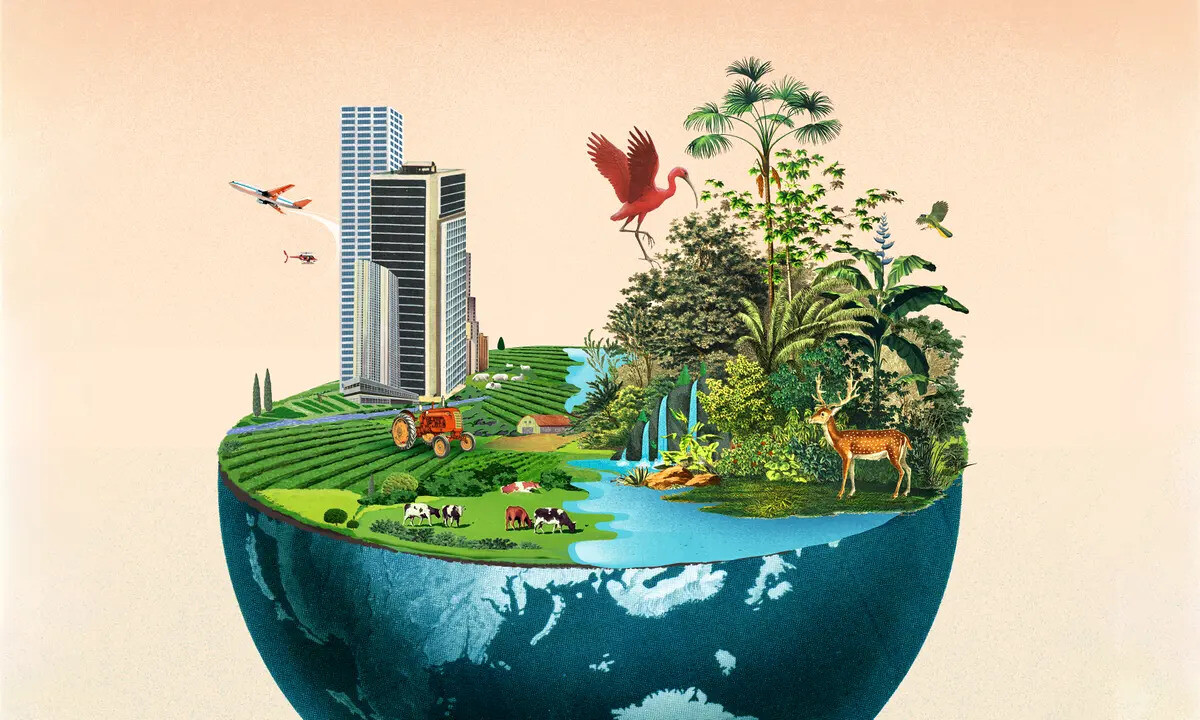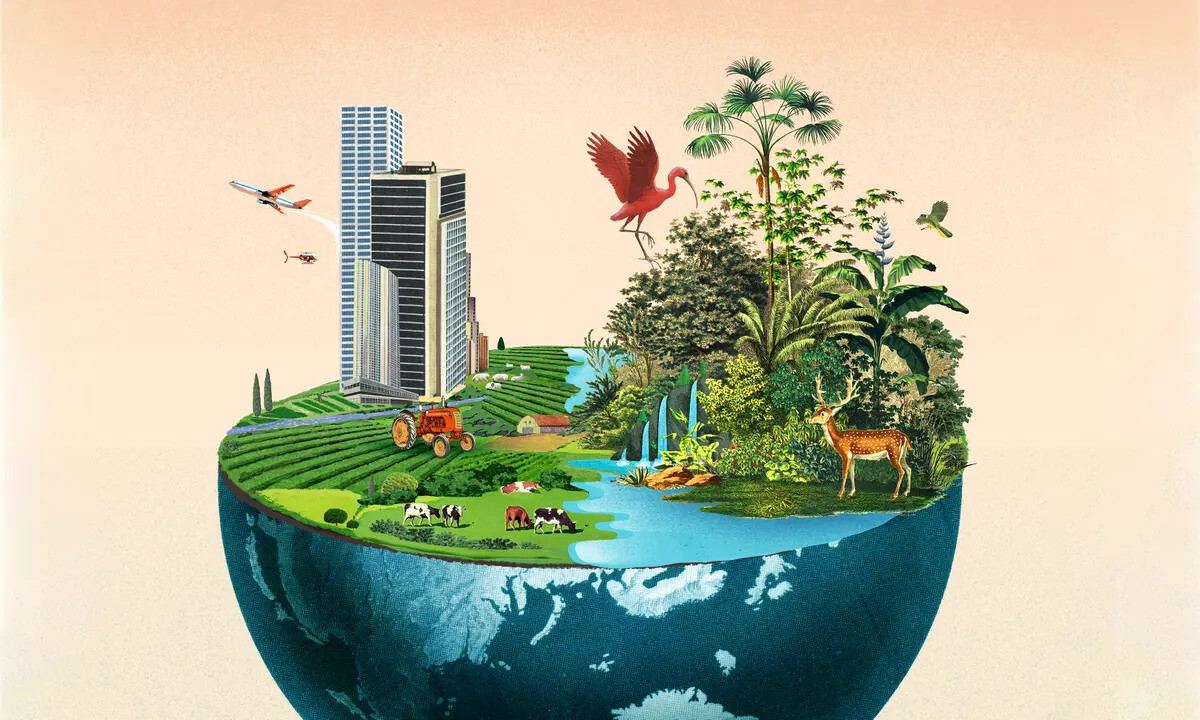

Illustration by Valero Doval
In our time the word “utopia” is only rarely mentioned. However, the utopian desire has not completely disappeared. When we speak about utopia, we speak about time at a standstill. A time without change. A moment that is so beautiful that we want it to become eternity. Earlier, one believed that this state of standstill could and would be reached at the end of historical movement. Of course, some theoreticians of postmodernity told us that we already lived after the end of history. But now we hear that postmodernity is passé and the train of progress goes further. It is not good news. It is tiring to live on a moving train. Thus, we cannot simply give up the utopian desire to reach the end station. But if the end station is unreachable, maybe it is better to leave the train?
Instead of looking for a standstill in time, one begins to look for a standstill in space. In our culture, this type of standstill in space is traditionally found in libraries and museums. They accumulate artefacts instead of destroying them—unlike technological progress, which replaces old things with new things, thus destroying the old things and old ways of life. Foucault famously spoke about museums as “heterotopias.” A heterotopia is a standstill space beside and beyond the mainstream politico-technological process. The border between history and heterotopia is drawn not in time, like the border between history and utopia, but in space, like the border between museums and ordinary life space. This border isolates museum artefacts, which are protected from the destruction wrought by the movement of time, from the things of ordinary life, which remain unprotected and are thus destined to be destroyed. Progress creates by destruction; heterotopias are created by protection.
Today, establishing the borders of heterotopias has become the central political problem of our time. Insofar as culture has been understood as the sum of cultural goods, such as books, artworks, music pieces, and films, the coexistence of technological progress and heterotopias has basically been an economic and administrative problem. It has been a matter of how much resources a society is ready to divert from the production of utilitarian goods to the protection of cultural goods. However, throughout the twentieth century the idea of culture went through a deep transformation. Culture came to be understood as a specific life-form, and not as a mere collection of artefacts. Thus, if I want to protect a certain life-form, I have to put human beings who are practicing this life-form inside the system of museum protection, isolating them from the movement of history. This is, of course, a political and not merely an economic or administrative decision. As an example of this shift from the understanding of culture as a sum of cultural goods towards the understanding of culture as a life-form, let us take Heidegger’s Origin of the Work of Art (1935–36).
It is well known that in this book Heidegger discusses a painting by Van Gogh that depicts a pair of shoes. Heidegger writes that these dirty, worn-out shoes reveal the world of a peasant woman who spent her life working hard on the land. In fact, Van Gogh depicted his own shoes in this painting. But that is not the point here. For Heidegger, these shoes opened up the gaze to the world of peasant life—a world in which both Van Gogh and Heidegger had also participated. Van Gogh wandered through fields in search of motifs for his paintings; Heidegger lived in a village. Both Van Gogh and Heidegger shared with the peasant woman the same work of the cultivation of the earth—and thus belonged to the same culture. It is this culture, this life-form, that is, according to Heidegger, the origin of the work of art. It also constitutes an artwork in itself. When we are living inside a certain culture it means that we are living inside an artwork. A painting, like Van Gogh’s painting, reveals this life-form that otherwise would remain hidden from our view. However, this revelation is valid only insofar as the life-form that it reveals remains our own life-form. That is why for Heidegger the preservation of a particular artwork does not mean its mere conservation and restoration in a museum. Rather, it means the preservation of the way of life that is manifested in this artwork. Only then, Heidegger writes, do the creation and preservation of the artwork come together. This is the decisive intellectual move that Heidegger makes here. Aesthetic value is transferred from an individual artwork to the life-form that is revealed in this artwork.
The transfer of aesthetic value from cultural goods to the human life-forms that have produced them recalls the transfer of aesthetic value from individual animals to their natural environments. What is at stake is the self-aestheticization of humanity, which follows the aestheticization of plants, animals, and fish—an aestheticization that is at the core of the contemporary ecological movement. The aestheticization of living nature started with European zoos, which presented individual animals of different species. These zoos functioned like museums and libraries; they strove to be representative and produce an overview of the world’s fauna. However, people eventually realized that different species require different ecological environments for their “natural” survival. Animals taken out of their ecological niche lose their identity. Thus national parks took the place of zoos, where the life-forms of different animals were protected from technological progress. The contemporary ecological movement is nothing other than an attempt to turn the whole earth into a national park. But when we ask why we should protect all these animal species from disappearance, the answer is: because otherwise the world will lose its visual diversity, its richness of forms and colors. In other words, the answer is an aesthetic one.
There is no doubt that the protection of cultural diversity against its homogenization through technological progress is analogous to the protection of biological diversity. Both cases are a matter of a certain aesthetic taste—and a politics of aestheticization and self-aestheticization based on this taste. This is a taste that prefers diversity to monotony and difference to repetition. In other words, it is a taste that prefers the products of preindustrial manual labor to industrially produced products. In our time the protection of preindustrial life-forms has become a widespread artistic practice. Many artistic projects combine a focus on preindustrial manual labor with a defense of populations left behind by technological progress. The goal of these projects is not to integrate these populations into the movement of progress through educational or other means, but, on the contrary, to protect their traditional ways of life from the onslaught of technological progress. But when we speak about the protection of cultural heterotopias, what do these have to be protected from? Obviously, they should be protected in the first place from migration.
One can say that the traditional understanding of culture as a sum of cultural goods has privileged migrants over native populations, whereas the new ecological understanding of culture as a cultural space or cultural niche privileges native populations vis-à-vis migrants. If we believe that a book or a painting does not lose its value when it is transported from one area to another—for example, from China to Europe and back—then it is reasonable to collect the book or painting in a library or museum. However, if we, like Walter Benjamin, believe that cultural goods lose their aura in transit and thus reach their destination as mere things, then their privileged position becomes absurd—and culture begins to be understood as what happens in “real life,” outside museums and libraries and not inside them. That is why migration is the focus of many contemporary political discussions. Protecting cultural spaces, understood as heterotopias, means, among other things, restricting immigration into these areas. The liberal politics that more or less favors migration because it is needed by technological progress has provoked opposition from both the left and the right. The motivation of these two types of opposition is the same: to create and protect cultural heterotopias. The difference is merely in the choice of heterotopias to protect.
Many on the left want to protect spaces of native, traditional cultures from Western colonialism. Many on the right want to protect Western culture from the alleged harm caused by emigration from non-Western countries. And it is characteristic that both of these political forces operate in the name of diversity. Thus, those on the left protect the territories of precolonial cultures in the name of global diversity. But global diversity presupposes cultural homogeneity inside the protected territories. The same can be said about rightist political strategies. They have as a goal the protection of the territories of Western cultures in order to guarantee their cultural diversity. And here again the price of global cultural diversity is the homogeneity of the “majority” cultures. In both cases global diversity has local homogeneity as its shadow.
Of course, in Western countries the left fights for cultural diversity inside these countries—for immigration and the rights of minority cultures vis-à-vis the dominance of the majority culture. However, are the immigrants expected to bring their own minority cultures with them? Here one can say about immigrants what was already said above about cultural goods like paintings and books: as they leave their original territory, they lose their specific cultural aura—and become people like everybody else.
In this respect, it is helpful to look at T. S. Eliot’s analysis of migration in his book Notes Towards the Definition of Culture (1948). Similar to Heidegger, Eliot rejects the understanding of culture as a sum of cultural goods. Instead, he understands culture as an ecologically defined biotope for the reproduction of a specific kind of human animal. Migration is a danger to such a biotope. And here Eliot distinguishes between two types of migration. Earlier individual tribes and small ethnic groups, he writes, migrated in their entirety—so that they brought their culture, their way of life, with them. However, today’s migration does not happen primarily on the level of the whole Volk. Contemporary migrants, Eliot says, are individuals who have left the original territory of their culture, and thus do not transport their culture in its entirety. This diasporic, dispersed form of migration is not able to create the new compact cultural spaces that would produce a new, living, and livable culture. In fact, they represent a world culture which, Eliot writes, “ is something that we cannot imagine.” Thus, from the perspective of the political right, immigrants are rejected not as “people with a different cultural identity” but, rather, as agents of the “big world”—the world without any specific cultural identity. In other words, migration is perceived as coming from the future—a future that looks more dystopian than utopian. This is the source of attacks against immigration that have become so widespread in recent times.
We can speak here about attacks not so much against the flow of migration as against the flow of time. Indeed, even if I remain within my own protected cultural space, the movement of time takes me—together with this space—further and further away from my cultural origins. I migrate in time, even if I do not migrate in space. Without moving to another place, I begin to feel myself as a foreigner in my own land—an uncanny feeling that I tend to suppress. The suppression functions well insofar as I remain surrounded by familiar faces, hear people speaking a familiar language, and see them eating familiar food. But what happens when I see a Chinese restaurant around the corner? Do I think that I am now confronted with Chinese cultural identity? Of course not. I just realize that my place has become like any other place in the world, where one can eat Chinese food. As global diversity produces local homogeneity, local diversity produces global homogeneity. In all its versions, diversity is always accompanied by homogeneity as its shadow.
